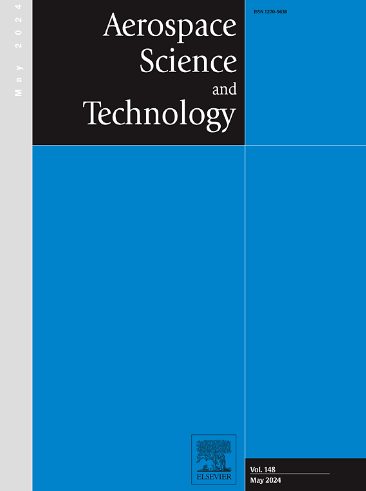Nonlinear guided waves in improved silicon solar cells using mathematical modeling and a bio-inspired artificial intelligence algorithm
IF 5
1区 工程技术
Q1 ENGINEERING, AEROSPACE
引用次数: 0
Abstract
Solar cells are crucial in aerospace industries as they provide a reliable and sustainable power source for spacecraft and satellites, enabling long-duration missions without relying on conventional fuel. This study investigates the propagation of nonlinear guided waves in improved silicon solar cells reinforced by graphene platelet (GPL) nanocomposites. The microplate model of the solar cells is developed using the modified couple stress theory (MCST) to capture size-dependent effects, and the sinusoidal shear deformation theory (SSDT) is applied to account for realistic shear deformation behavior. Nonlinear governing equations describing the dynamic response of the system are derived using Hamilton's principle. The equations are then solved numerically using the Runge–Kutta method to analyze the phase velocity and wave characteristics under varying parameters. The effects of GPL weight fraction, length scale parameter, and wavenumber on wave propagation are thoroughly examined. In this investigation, an intelligent model based on deep neural networks as an artificial intelligent algorithm combined with a genetic algorithm (DNN-GA) as a bio-inspired optimization approach, is employed to predict nonlinear phenomena in guided waves within the solar cell, using datasets generated from mathematical simulations. The results demonstrate that the inclusion of GPL nanocomposites enhances the mechanical properties of the silicon solar cells, leading to higher phase velocities and improved wave propagation efficiency. Additionally, the influence of the length scale parameter on phase velocity is found to be significant, particularly for low wavenumbers. This study provides valuable insights into the optimization of advanced nanocomposite-reinforced silicon solar cells for applications requiring efficient guided wave propagation. The findings offer a promising approach for the design and enhancement of next-generation solar cells.
利用数学建模和生物启发人工智能算法实现改进型硅太阳能电池中的非线性导波
太阳能电池在航空航天工业中至关重要,因为它们为航天器和卫星提供了可靠、可持续的电源,使长时间任务无需依赖传统燃料。本研究探讨了石墨烯平板(GPL)纳米复合材料增强的改进型硅太阳能电池中非线性导波的传播。利用修正耦合应力理论(MCST)建立了太阳能电池的微板模型,以捕捉尺寸相关效应,并应用正弦剪切变形理论(SSDT)来解释现实的剪切变形行为。利用汉密尔顿原理推导出描述系统动态响应的非线性控制方程。然后使用 Runge-Kutta 方法对方程进行数值求解,分析参数变化时的相位速度和波浪特性。对 GPL 重量分数、长度尺度参数和波数对波传播的影响进行了深入研究。在这项研究中,采用了一种基于深度神经网络的智能模型,将其作为一种人工智能算法,并结合遗传算法(DNN-GA)作为一种生物启发优化方法,利用数学模拟生成的数据集预测太阳能电池内导波的非线性现象。结果表明,GPL 纳米复合材料的加入增强了硅太阳能电池的机械性能,从而提高了相位速度,改善了波的传播效率。此外,研究还发现长度尺度参数对相速度的影响很大,尤其是在低波数情况下。这项研究为优化先进的纳米复合材料增强型硅太阳能电池提供了宝贵的见解,使其适用于需要高效导波传播的应用领域。研究结果为设计和改进下一代太阳能电池提供了一种前景广阔的方法。
本文章由计算机程序翻译,如有差异,请以英文原文为准。
求助全文
约1分钟内获得全文
求助全文
来源期刊

Aerospace Science and Technology
工程技术-工程:宇航
CiteScore
10.30
自引率
28.60%
发文量
654
审稿时长
54 days
期刊介绍:
Aerospace Science and Technology publishes articles of outstanding scientific quality. Each article is reviewed by two referees. The journal welcomes papers from a wide range of countries. This journal publishes original papers, review articles and short communications related to all fields of aerospace research, fundamental and applied, potential applications of which are clearly related to:
• The design and the manufacture of aircraft, helicopters, missiles, launchers and satellites
• The control of their environment
• The study of various systems they are involved in, as supports or as targets.
Authors are invited to submit papers on new advances in the following topics to aerospace applications:
• Fluid dynamics
• Energetics and propulsion
• Materials and structures
• Flight mechanics
• Navigation, guidance and control
• Acoustics
• Optics
• Electromagnetism and radar
• Signal and image processing
• Information processing
• Data fusion
• Decision aid
• Human behaviour
• Robotics and intelligent systems
• Complex system engineering.
Etc.
 求助内容:
求助内容: 应助结果提醒方式:
应助结果提醒方式:


